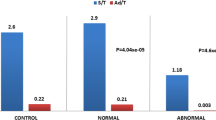Abstract
Among 460 children who had an orchiopexy (ORP), we identified 72 children who had attended our institution 1–12 years earlier and in whom the testicular position had been specified. Of the 72 boys 19 were had ascended testes (26%). The age at ORP of the children with ascent of the testes was 7.0 years (1.8–14.0 years). Light and electron microscopy of 13 testicular biopsies taken at ORP, showed alterations of germ cells and sertoli cells, similar but less pronounced than alterations seen in congenital undescended testes.
Conclusion
A normally positioned testis may ascend into the inguinal region or upper scrotum and remain there fixed. This secondary cryptorchidism does not usually respond to human chorionic gonadotropin treatment and must be corrected by orchiopexy.
Similar content being viewed by others
Abbreviations
- CRY :
-
cryptorchidism
- EM :
-
electron microscopy
- HCG :
-
human chorionic gonadotropin
- ORP :
-
orchiopexy
- S/T :
-
average number of germ cells per cross sectioned seminiferous tubule
References
Atwell JD (1985) Ascent of the testes: fact or fiction. Br J Urol 57:474–477
Belman AB (1988) Acquired undescended (ascended) testis: effects of human chorionic gonadotrophin. J Urol 140:1189–1190
Eardley I, Saw KC, Whitaker RH (1993) Surgical outcome of orchiopexy. II. Trapped and ascending testes. Br J Urol 73:204–206
Fenton EJM, Woodard AA, Hudson IL, Marschner I (1990) The ascending testis. Pediatr Surg Int 5:6–9
Hadziselimovic F, Herzog B (1987) Cryptorchidism. Pediatr Surg Int 2: 132–141
Hadziselimovic F, Herzog B (1990) Hodenerkrankungen im Kindesalter. Hippokrates Verlag, Stuttgart
Hadziselimovic F, Herzog B, Seguchi H (1975) Surgical correction of cryptorchidism at 2 years: electron microscopic and morphometric investigations. J Pediatr Surg 10:19–26
MacKellar A (1988) Undescended testis: how history and examination may influence treatment. Aust N Z J Surg 58:643–645
Mengel W, Heinz HA, Sippel WG, et al (1974) Studies on cryptorchidism: a comparison of histological findings before and after the second year of life. J Pediatr Surg 9:445–450
Myers NA, Officer CB (1975) Undescended testes: congenital or acquired? Aust Paediatr J 11:76–80
Rune GM, Mayr J, Neugebauer H, Anders CH, Sauer H (1992) Pattern of Sertoli cell degeneration in cryptorchid prepubertal testes. Int J Androl 15: 19–32
Schiffer KA, Kogan SJ, Reda EF, Levitt SB (1987) Acquired undescended testes. Am J Dis Child 141: 106–107
Welkowitz J, Ewen RB, Cohen J (1982) Introductory statistics for the behavioral sciences, 3rd edn. Harcourt Brace Jovanovich, Orlando, pp 157–214
Author information
Authors and Affiliations
Rights and permissions
About this article
Cite this article
Mayr, J., Rune, G.M., Holas, A. et al. Ascent of the testis in children. Eur J Pediatr 154, 893–895 (1995). https://doi.org/10.1007/BF01957500
Received:
Accepted:
Issue Date:
DOI: https://doi.org/10.1007/BF01957500




